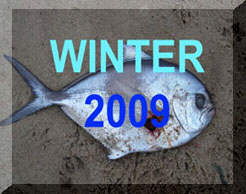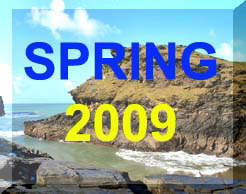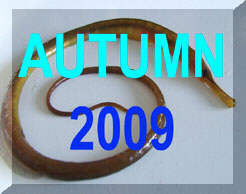LATEST
NEWS:
27
September 2009
On
a dive out of John
o' Groats (the most northerly settlement of mainland Scotland) I discovered
the rarely reported free swimming tunicate Thetys vagina
as well as the Mauve Stinger Jellyfish, Pelagia
noctiluca, both seen in shallow (10 metres deep) water, within
two or three metres of the surface. Thetys was observed swimming
by opening and closing its mouth and propelling itself along under the
cliffs at Skirza
Head (eastern coast).

Thetys
vagina has been rarely recorded in Irish
waters. The species was reported for the first time in Irish waters during
November
1988 when hundreds of specimens were taken
in trawls at offshore. A few specimens were also found stranded on Ventry
Beach, near Dingle,
County Kerry during July 1987 & 1988.
BMLSS
Tunicata
BMLSS
Jellyfish
24
September 2009
A
four metre long Thresher Shark, Alopias
vulpinus, was discovered washed up on Hayle
Beach, Cornwall.
22
September 2009
A
Cornish Blackfish, Schedophilus
medusophagus, was caught in in a
pelagic
trawl about five miles west of the Mull
of Galloway
(south-west Scotland) and was weighed in at Portaferry
(Northern Ireland) at 3.5 kg gutted weight. The vessel which caught the
fish was the FV. Ambitious,
skipper/owner Eric Cully.

Cornish
Blackfish
Photograph
by Alan Mawhinney
This
was an unusual capture of a widespread mesopelagic
fish, found on both sides of the North Atlantic
Ocean but it is normally found at depths greater
than 200 metres so it is not caught in nets for the usual commercial species.
This sub-tropical
fish is also found in the Mediterranean Sea.
Schedophilus
medusophagus is a relatively common bathypelagic
species off the west coast of Ireland. I have seen several of them landed
with Blue Whiting,
Micromesistius
poutassou, in Killybegs,
Donegal.
Previous
Report
September
2009
A
Giant
Goby, Gobius
cobitus, was photographed in a rockpool
at Gerrans,
south Cornwall.
Link
to a Photograph (by Andy Rapson)
BMLSS
Giant Gobies
21
September 2009
Just
a mile from the centre of Glasgow,
a four metre long baby Northern Bottle-nosed
Whale, Hyperoodon
ampullatus, swam up the River
Clyde and was seen from Arc
Bridge.
"The
poor creature is currently showing very unusual behaviour, which could
be to do with its current location. It has become stranded a few times
but each time has managed to get itself back into slightly deeper water,"
said
Trevor Weeks of British Divers Marine
Life Rescue (BDMLR). "If the whale has
not been weaned, unfortunately, there is not much chance of it staying
alive. Even if we can return it to the sea, there is very little chance
of reuniting it with its parents, on which it depends for food."
BDMLR
Report
19
September 2009
There
was a large stranding of jellyfsh-like Aequorea
forskalea on Treyarnon
Beach, North Cornwall coast.
Featured
Species: Aequorea
BMLSS
Aequorea Notes
BMLSS
Jellyfish and other Medusa
16-17
September 2009
A
close inshore sighting of a 9 metre long Northern
Bottle-nosed Whale, Hyperoodon
ampullatus, in Poole
Bay, Dorset, and seen from Bournemouth
Pier,
was a notable observation giving cause for concern that this deep water
whale was injured or sick.
The Bottle-nosed
Whale was washed up dead on Bournemouth beach
in the evening of 21 September 2009 on
the high spring tide.
2008
Stranding Report
10-12
September 2009
A
9.5 metre long Humpback Whale, Megaptera
novaengliae, was discovered washed
up dead at Erith, Greater
London, in the River
Thames. On 10 September 2009 a
large whale was spotted at Tilbury
at least ten miles to the east (where the river narrows to 732 metres wide)
and this is believed to be the same one. The young male Humpback
Whale is believed to have starved to death.
The
main food items of Humpback Whales
seems to be small shoaling fishes and large zooplankton, including krill-like
Amphipods.
This
is the first record of a Humpback
Whale recorded in the Thames, although
a large whale of this species was
washed up dead on the north Kent coast at Deal
in 2006. The
Humpback
Whale is a deep water species but these whales
occasionally wander into the southern North Sea where they can become disorientated
and starve to death. In 2006
another
young whale became lost and died in the Humber. In 2006
it was a Northern
Bottle-nosed Whale that was washed up dead
up at Lambeth in London.
BBC
News Report
BDMLR
Report
Whales
and Dolphins in British Seas (by Steve Savage)
BMLSS
Cetacea News Index
UK
Cetacean Strandings Investigation Programme (CSIP)
Identification
Key for Stranded Cetaceans
Whale
Watching (Britain)
How
to Report a Stranding
c 26
August 2009
A
Broad-billed
Swordfish,
Xiphias
gladius,
was discovered in the Kattegat,
the shallow sea to the east of Denmark. It was alive but died shortly afterwards
in only 50 cm of water at Oreby Port,
three kilometres from the mouth of the fjord.
"'Swordfish
are seen occasionally in the North Sea in late summer, but it is unusual
that it made so far into the inner Danish waters as Sakskøbing Fjord.
As far as I can see, it is not described before in literature,"
said biologist Karsten Bjerrum Nielsen (Kattegat
Center), who believes that the catch was sensational. The fish was
put on display at the Kattegat Center from 13
October 2009.
Full
Report
BMLSS
Swordfish
19
August 2009
Green
seaweed has been clogging parts of the
English coastline, and from the air above Langstone Harbour in Hampshire
it resembles a massive algal green carpet. This amount of seaweed has a
detrimental effect on the underlying fauna deoxygenating the mud and killing
the worms and cockles etc.
BBC
News Report
The
continual problem also occurred off the shores of Brittany.
BBC
News Report
17
August 2009
A
line fishermen, Ingibergur
G. Thorvaldsson, caught
a huge Ling,
Molva
molva, of
51 kg in 2009 off
Iceland. This is a very large specimen exceeding in size of any caught
around the British Isles.
16
August 2009
A
most surprising capture in an angling competition in the saline Humber
estuary (at Hessle underneath
the Humber Bridge)
was a Wels Catfish,
Silurus
glanis,
caught by Mark Taylor
on light tackle fishing for Eels
and Flounders.
This freshwater fish weighed in at 2.3 kg (5 lb) and measured 57
cm in length.

Catfish,
Silurus
glanis
The
Wels
Catfish is an alien species from central
Europe (River
Danube) but known from the lower reaches
of the major river systems in England for over a century. Some populations
of this catfish will breed in salt water (Aral
Sea).
12
- 14 August 2009
Thousands
of fish have died of suffocation in the seas of St.
Austell Bay in south Cornwall.
"The
more we looked, the more dead fish we found, mainly small ones, but eventually
even about half a dozen Cuckoo Wrasse,
Labrus
bimaculatus, - a beautiful red and
blue fish, and some others which someone identified as baby Dogfish,
Scyliorhinus
canicula,
all unmarked but dead in
rock pools or on the shoreline. One chap even hauled out a large Conger
Eel, Conger conger, from a pool,
obviously dead."
The
dead fish coincided with a large bloom
of plankton that had been blown into the bay. The bloom had turned
the water brown and left sludge deposit on the shore. The exact species
has been identified as the dinoflagellate, Karenia
mikimotoi.
Western
Morning News Report
Wild
About Britain Forum (Report)
BBC
News Report (1)
BBC
News Report (2)
Web
Site Report by David
Fenwick
Selected
microphytoplankton species from the North Sea
BMLSS
Algae
10
August 2009
A
15 cm juvenile Loggerhead Turtle,
Caretta
caretta, was rescued after stranding on Loe
Bar, near Porthleven,
in Cornwall. It was discovered by by Rose
Ledbury from Warwick. The turtle was surrounded
by a number of stranded Portuguese Man-o'War, Physalia
physalis, one of the Loggerhead's
staple foods. The turtle is recovering in a special quarantine unit at
the Blue Reef Aquarium in Newquay.
BMLSS
Turtles
BMLSS
Portuguese Man-o'War
2 August
2009
A
Bogue,
Boops boops,
was caught in a Red Mullet
net in 10 metres of water about half a mile off the shore at Seaton, south
east Cornwall, by Chris Dominic on the FV
Emma May.
This
fish was about 17 cm (6 - 7"), but they can grow to 38 cm (14").
They are a shoaling fish and are a commercial species in southern Europe.
They are classified in the Sparidae Sea Bream
family and I assume they are good eating. They are rare in British
waters and most have been caught in the Channel Islands, but they have
also been found in Torbay and several other places. They are regularly
caught in Red Mullet nets in Mount's Bay Cornwall in the autumn, but this
is the first I had heard of from Whitsand Bay.
BMLSS
Sea Breams
19
July 2009
Two-banded
Sea Bream,
Diplodus vulgaris,
have
again been identified from the shallow seas of Belle
Greve Bay, on the east coast of Guernsey, Channel Islands. This
silvery sea-bream has a distinctive black band
on its caudal peduncle (preceding its tail fin).
BMLSS
Sea Breams
Full
Report
9 July
2009
Commercial
crab and lobster fisherman Clive Brown
brought me a live Common Octopus, Octopus
vulgaris, which he landed in one of his
pots to the north-west of Les
Hanois Lighthouse
, south-west of Guernsey,
Channel
Islands, at 10:00 am.
This octopus was missing one arm. The injury had healed.

All
reports of Octopus vulgaris
in Channel Island waters are of interest because of their virtual disappearance
after the cold winter of 1962/ 1963.
They began to re-appear in small numbers several years ago and then disappeared
again. Clive Brown reports one being caught in the same location as his
capture by another fisherman five years ago. They may move in from deeper
water to the west of Guernsey.
Octopus
vulgaris has two rows of suckers per arm
and grows to a much larger size than Eledone
cirrhosa, which has one row of suckers
per arm.
Previous
Report
BMLSS
Octopuses
2 July
2009
A
newly born (neonate) Porbeagle Shark,
Lamna
nasus, was caught and released by a young
angler off the Great Bank off the east coast of Guernsey,
Channel
Islands.
Andy Simon
(father of the angler) wrote that the neonate shark weighed about 7 kg
(15 lb) and was about a metre long. It was caught at 4.30
pm out from Fermain Bay.
Porbeagle Sharks usually
produce two young per uterus (four in total per litter) after a long gestation.
The embryos are oophagous. The mother only fertilises two eggs in each
uterus but she produces copious amounts of eggs during gestation, which
the developing embryos eat. The embryos have sharp teeth to tear the skin
of the eggs apart. The developing embryos have a large abdominal yolk sac,
which they absorb during development. During the colder months Guernsey
fishermen catch Porbeagle Sharks occasionally.
The captured adult females usually carry embryos. It appears that
Channel Island waters are a nursery ground for Porbeagle Sharks
as
there is evidence that Porbeagle Sharks
give
birth there.
Images
of Embryos (by Richard Lord)
BMLSS Sharks
: Porbeagle
BMLSS
Shark & Ray News
BMLSS
Porbeagle -1
BMLSS
Porbeagle -2
Large
Porbeagle Sharks
Summary
of Porbeagle (Lamna nasus) litters from Guernsey and Jersey
IUCN
Red List Endangered Species: Porbeagle Shark

British
Marine Life News 2008
Cornish
Marine Life 2008 (Ray Dennis Records)
BMLSS
Oil Disasters page


















